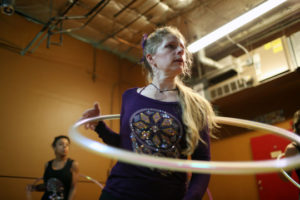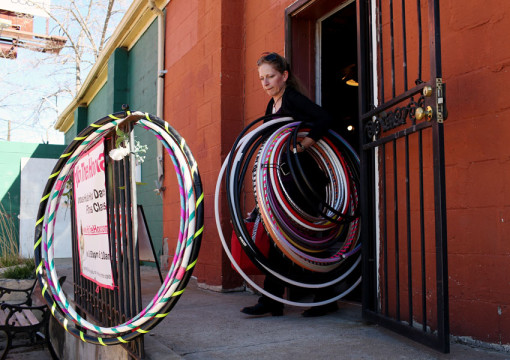Media
Hip The Hoopla and Che’ Rippinger
Media Appearances
Radio appearance for Hooping Idol 7 on 103.5 The Fox Rock Station
Newspaper and Online Article with Aurora Magazine/Aurora Sentinel

20150321-Hooper-Denver, Colorado-Ché Rippinger teaches her hula hoop fitness class on Saturday March 21, 2015 at her studio in Denver.
Photo by Gabriel Christus/Aurora Sentinel
Hoop To It — Colorado’s Growing Centrifugal Force
“It’s like if you screw up in life, pick it up like you meant to do that,” Rippinger says as she seamlessly whips the hoop from near her feet to her waist as if it’s completely weightless and just another appendage on her body.
You can hit 20 minutes on the Abdomenizer or a grab a glass a wine and do 20 minutes with your hoop,” says, Che’ Rippinger, a Denver-based dancer who has been hula hooping for more than six years. On a sunny Saturday morning in a former garage converted into a studio, Rippinger led a group of seven women through a mixture of a hula hooping sprinkled with yoga, belly dance, and well — lots of laughing.
Much of it due to Rippinger’s wit.
“I do not recommend throwing a baby, but if you had to throw a baby out of a burning building to save the baby, you must treat the baby really well,” she says while demonstrating a more advanced move that involves keeping the hoop spiraling around her chest during the class.
But despite the smiling faces, “hooping” — as die-hard fans of the round, shiny object like to call it — is no laughing matter.
Especially when it comes to working your core. In fact, you can burn up to seven calories per minute, according to American Council on Exercise, by just hula hooping. That adds up to 210 calories per 30 minute session. So in Rippinger’s class, which last for an hour, you can leave assured you’ve burned off that Starbucks Ham & Cheese Savory Square you ate in your car.
And the shimmering hoops used in Rippinger’s class are not to be mistaken for the Whamo-O-brand multi-colored plastic tubes you messed around with in the backyard as a kid.
Rippinger even crafts custom hoops that range from large, on-body waist hoops to mid-sized hoops that allow the user to delve into advanced on- and off-body tricks, to mini hoops that come in pairs and are used for advanced hooping tricks. There are even collapsible hoops so you can take your hoop on your bike to the park or while traveling.
Beginners are supposed to start out with adult hoops, which are larger hoops that are easier to use because they rotate around you more slowly.
But lets not get ahead of ourselves. It all starts with waist-hooping. Yes, there are different parts of your body that can “hoop,” the waist ostensibly being the easiest and the foundation for hoopers.
When the actual hooping in Rippinger’s class commences is also when you start to hear the “thwop” of rings hitting the ground.
“It’s like if you screw up in life, pick it up like you meant to do that,” Rippinger says as she seamlessly whips the hoop from near her feet to her waist as if it’s completely weightless and just another appendage on her body.
With the hooping motion, at least as far as waist hooping goes, the hoop spins around your body from the momentum provided by rocking your hips back and forth rather than in a circular motion. When the hoop starts to slide down, you can speed up the back-and-forth rocking to bring the hoop back up. Once you get comfortable, Rippinger has you do fun tests like closing your eyes and turning 360 degrees while hooping, which is also strangely a recovery technique because it forces you to get out of your head and just feel the hooping motion.
“Sometimes we just have to wrap our mind and body parts around it, too,” Rippinger says. “I teach health and happiness, and it comes from the inside out. A lot of people are worried about exterior looks, but I find if you’re happy on the inside, you will make better choices and decisions about yourself and your body. The hoop literally spirals around to hit these other areas of your life. If you drop it once, you don’t just go, ‘I’ll never do it again.’ You pick it back up.”
WHERE TO HOOP ( ** This info has changed–check current courses and offerings at www.HipTheHoopla.com **)
HISTORY BEHIND HULA HOOPING
The concept of the hula hoop dates back to ancient Egypt with children who played with hoops made out of dried grapevines, rolling them with sticks or whirling them around their waist.
The term “hula hoop” came from British sailors who had seen hula dancing in the Hawaiian islands and thought it looked similar to a game that swept 14th-century England that involved spinning hoops composed of sticks and grass around oneself. Apparently for the English, this resulted in doctors blaming the hoops for the ensuing heart attacks and back dislocations that resulted from the craze.
But it wasn’t until 1958 in the U.S. that Wham-O toy company founders Richard Knerr and Arthur “Spud” Melin saw hula hooping’s potential after the pair were introduced to the wooden exercise hoops used in gymnastics classes and their fun gyrating motion. Once businessmen started making 40-inch versions of the colorful plastic tubes, the hula hoop swept across the U.S., with teenagers shown hooping up a storm in Life magazine and on the Dinah Shore Show. Historians estimate the pair sold anywhere from 20 million to 40 million Wham-O hula hoops worldwide that year.
PHYSICS OF A HULA HOOP
Scientists compare the motion of a hula hoop spinning around a person’s waist to other oscillating objects like a swinging pendulum. When you stand in the middle of a hoop, you become the center of the ring’s rotation — or the axis. As the axis, you also represent the source of the hoop’s movement. When you move your body to propel the hoop around, you exert an upward force that comes from your hips as well as a turning force known as torque. The next force involved in hula hooping that keeps it revolving around you is friction. It’s similar to when a ball is rolling along a flat surface and eventually stops due to the friction created by the contact wit the surface. Like that surface, friction between the hooper’s clothes and the air slows the spinning down while also helping to keep the hula hoop up against the downward force of gravity.
Original Article at the Aurora Sentinel.


 20150321-Hooper-Denver, Colorado-Ché Rippinger teaches her hula hoop fitness class on Saturday March 21, 2015 at her studio in Denver. Photo by Gabriel Christus/Aurora Sentinel
20150321-Hooper-Denver, Colorado-Ché Rippinger teaches her hula hoop fitness class on Saturday March 21, 2015 at her studio in Denver. Photo by Gabriel Christus/Aurora Sentinel 20150321-Hooper-Denver, Colorado-Ché Rippinger , top right, gets her class together in a circle at the end of class on Saturday March 21, 2015 at her studio in Denver. Photo by Gabriel Christus/Aurora Sentinel
20150321-Hooper-Denver, Colorado-Ché Rippinger , top right, gets her class together in a circle at the end of class on Saturday March 21, 2015 at her studio in Denver. Photo by Gabriel Christus/Aurora Sentinel 20150321-Hooper-Denver, Colorado-on Saturday March 21, 2015 at her studio in Denver. Photo by Gabriel Christus/Aurora Sentinel
20150321-Hooper-Denver, Colorado-on Saturday March 21, 2015 at her studio in Denver. Photo by Gabriel Christus/Aurora Sentinel 20150321-Hooper-Denver, Colorado-Ché Rippinger brings her hoops out to her car after class on Saturday March 21, 2015 at her studio in Denver. Photo by Gabriel Christus/Aurora Sentinel
20150321-Hooper-Denver, Colorado-Ché Rippinger brings her hoops out to her car after class on Saturday March 21, 2015 at her studio in Denver. Photo by Gabriel Christus/Aurora Sentinel 20150321-Hooper-Denver, Colorado-Ché Rippinger teaches her hula hoop fitness class on Saturday March 21, 2015 at her studio in Denver. Photo by Gabriel Christus/Aurora Sentinel
20150321-Hooper-Denver, Colorado-Ché Rippinger teaches her hula hoop fitness class on Saturday March 21, 2015 at her studio in Denver. Photo by Gabriel Christus/Aurora Sentinel